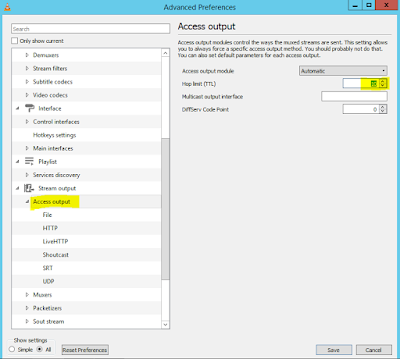Today, while working on a multicast lab on Cisco Router. I build a lab to send multicast stream from one end to other end via VLC. I found that, while checking router with "show ip mroute" command , receiver PC was successful registering with Rendezvous Point Server to receive required multicast traffic but the Multicast source (Sender) was not registering with RP.
Upon a day's troubleshooting, i found in the packet capture that VLC Sender is sending multicast traffic with TTL Value 1, this is default behavior of VLC player and which will definitely be discarded by first receiving hop.
So I have to increase the TTL value little higher so that the multicast packets can traverse to some hops and reach the receiver.
To change the TTL value of the packet for sending multicast stream from VLC, you can change the default settings as per give below path and snap.
I also tried this in GNS3 and was working fine.
Go to Tools > Preferences > Select ALL radio button at left bottom > Expand Stream Output > Click Access output > Increase the TTL Value as per your network requirement or at least to 10
Note:- Restart VLC player after changing these settings.
Upon a day's troubleshooting, i found in the packet capture that VLC Sender is sending multicast traffic with TTL Value 1, this is default behavior of VLC player and which will definitely be discarded by first receiving hop.
So I have to increase the TTL value little higher so that the multicast packets can traverse to some hops and reach the receiver.
To change the TTL value of the packet for sending multicast stream from VLC, you can change the default settings as per give below path and snap.
I also tried this in GNS3 and was working fine.
Go to Tools > Preferences > Select ALL radio button at left bottom > Expand Stream Output > Click Access output > Increase the TTL Value as per your network requirement or at least to 10
Note:- Restart VLC player after changing these settings.

Comments
Post a Comment